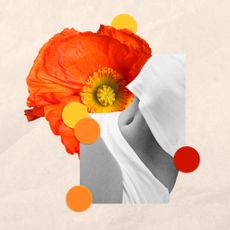

The Symptoms
Right around the time Katie Davis hit puberty at age 12, she started feeling fatigued all the time. "My whole family thought, 'You're just starting your period, you're moody,'" remembers Katie, now 22.
But then one day she stood up from a nap at her home in Ohio and fainted. She was taken to the hospital in an ambulance, where doctors ran blood tests. "I could barely wake up to see anyone at that point," Katie says. "I was physically unable to do anything. It was scary. I was so out of it."
One strange thing kept happening during her stay that confused both her and the medical staff: her heart rate and blood pressure would randomly rocket up or plummet so low that nurses would rush into her room thinking she was crashing—but she was just sleeping. The hospital soon discharged her without a diagnosis when all tests came back normal.
Back home, her daily quality of life quickly crumbled.
"I was stuck on a mattress on my living room floor for three months," Katie recalls. "Besides going to doctors, I never left the house." Her mom kept insisting to doctors that something wasn't right, but each one said the same thing: She's just going through puberty. She just got her period. She's just afraid to start middle school. "Doctors were telling me this was all in my head, and they wanted me to see a psychiatrist, but my mom never believed it," Katie says.
She ended up skipping sixth grade altogether while she suffered at home, needing her mother to bathe her and "do everything" since she could barely sit up. She lived like that for a full year.
Stay In The Know
Marie Claire email subscribers get intel on fashion and beauty trends, hot-off-the-press celebrity news, and more. Sign up here.
The Diagnosis
When she was 13, Katie visited a cardiologist for yet another test: the tilt table test. Katie was strapped to a movable table so the doctor could observe her heart rate and blood pressure while the table tilted her from lying down to standing. Usually, the heart rate and blood pressure go up a little bit, just like when you get up from a chair. But for Katie, after just four minutes, her vitals dropped, and she fainted.
The cardiologist diagnosed her with dysautonomia—a condition where the "automatic" functions of the body that don't require our conscious control, like temperature regulation, digestion, blood pressure, and heart rate, fail. There is no cure for Katie's type of dyautonomia, a fairly common condition called POTS (Postural Orthostatic Tachycardia Syndrome), which is estimated to affect 1 out of 100 teenagers and up to 3 million adult Americans. Approximately 80 percent of sufferers are young women of childbearing age.
"I was obviously happy to hear a doctor to tell me I'm not crazy," Katie says, "but with no medication and no cure, it was crushing at same time. You want something you can fix, not something you have to live with for life."
The causes of dysautonomia are varied and not well understood. Lauren Stiles, the president of the advocacy organization Dysautonomia International and a published POTS researcher, says that current research is focused on finding a connection between autoimmune diseases and POTS. About half of patients acutely—suddenly—come down with the condition, after triggering events that could include a viral infection, getting your period, pregnancy, or injury. But finding a diagnosis is often tough. According to one study of 700 patients, the average delay until diagnosis was nearly six years, and 83 percent of them were told it was all in their heads.
"A lot of medical conditions that primarily affect young women have a long history of being regarded as anxiety or PMS," says Stiles. "There's probably an inherent bias in medicine that if someone looks fine on the outside, there can't really be something that wrong with them."
Also, because POTS was only first clinically defined in 1993 by the Mayo Clinic, many doctors aren't aware of or trained in how to make the diagnosis, Stiles says, though her organization is working to change that via physician education courses around the country.
For Katie, learning her diagnosis was just the beginning of a long road of coping with a chronic illness.
The Aftermath
For the first several years after her diagnosis, Katie pushed through it as best she could and attended high school, though she was so physically exhausted that she slept through many classes. Her teachers knew, but she was afraid to tell her peers for fear of their judgment or disbelief that something was really wrong with her. "It's so hurtful to tell someone what you're going through and have them not believe you because you look fine," she says.
In her senior year, Katie met a guy whom she eventually fell in love with and confided in; they are now happily married and are building their first home together.
But she still can't stand up longer than three minutes, so she uses a wheelchair to get around. Since she can't work, she keeps busy with projects around the house—cooking, cleaning, decorating, reading. One day, she hopes to have a child through adoption or surrogacy and fulfill her dream of becoming a mom.
Katie's treatment now mostly consists of making sure she has enough salt in her system, drinking tons of fluid, and wearing compression socks, and she credits her husband and her family for helping her find the strength to tell her story.
"I have such a good support system," she says. "That's why I'm happy today."
Follow Marie Claire on Facebook for the latest celeb news, beauty tips, fascinating reads, livestream video, and more.
-
 All the Easter Eggs and Name Drops on Taylor Swift's 'The Tortured Poets Department,' Explained
All the Easter Eggs and Name Drops on Taylor Swift's 'The Tortured Poets Department,' ExplainedDigging through the fan theories so you don't have to.
By Quinci LeGardye Published
-
 This Week's Best On-Sale Picks Include a Tory Burch Bag and Pretty Silver Ballet Flats
This Week's Best On-Sale Picks Include a Tory Burch Bag and Pretty Silver Ballet FlatsWarm weather is finally here—it's time to dress like it.
By Brooke Knappenberger Published
-
 A Sporty It-Sneaker Era Is About to Begin
A Sporty It-Sneaker Era Is About to BeginNike's next Air models are designed for Olympic athletes, but they'll soon be all over street style.
By Halie LeSavage Published
-
 Senator Klobuchar: "Early Detection Saves Lives. It Saved Mine"
Senator Klobuchar: "Early Detection Saves Lives. It Saved Mine"Senator and breast cancer survivor Amy Klobuchar is encouraging women not to put off preventative care any longer.
By Senator Amy Klobuchar Published
-
 How Being a Plus-Size Nude Model Made Me Finally Love My Body
How Being a Plus-Size Nude Model Made Me Finally Love My BodyI'm plus size, but after I decided to pose nude for photos, I suddenly felt more body positive.
By Kelly Burch Published
-
 I'm an Egg Donor. Why Was It So Difficult for Me to Tell People That?
I'm an Egg Donor. Why Was It So Difficult for Me to Tell People That?Much like abortion, surrogacy, and IVF, becoming an egg donor was a reproductive choice that felt unfit for society’s standards of womanhood.
By Lauryn Chamberlain Published
-
 The 20 Best Probiotics to Keep Your Gut in Check
The 20 Best Probiotics to Keep Your Gut in CheckGut health = wealth.
By Julia Marzovilla Published
-
 Simone Biles Is Out of the Team Final at the Tokyo Olympics
Simone Biles Is Out of the Team Final at the Tokyo OlympicsShe withdrew from the event due to a medical issue, according to USA Gymnastics.
By Rachel Epstein Published
-
 The Truth About Thigh Gaps
The Truth About Thigh GapsWe're going to need you to stop right there.
By Kenny Thapoung Published
-
 3 Women On What It’s Like Living With An “Invisible” Condition
3 Women On What It’s Like Living With An “Invisible” ConditionDespite having no outward signs, they can be brutal on the body and the mind. Here’s how each woman deals with having illnesses others often don’t understand.
By Emily Shiffer Published
-
 The High Price of Living With Chronic Pain
The High Price of Living With Chronic PainThree women open up about how their conditions impact their bodies—and their wallets.
By Alice Oglethorpe Published